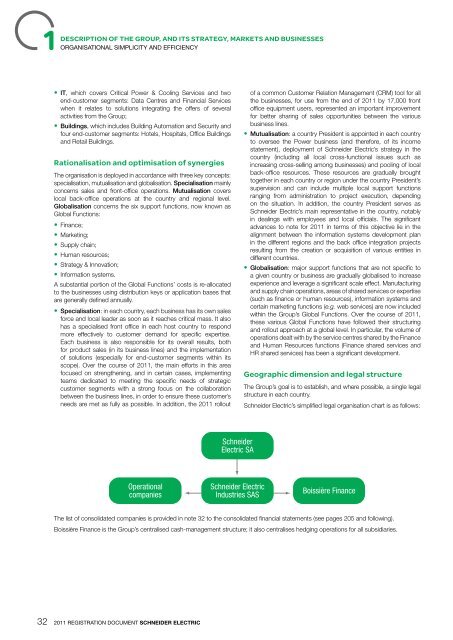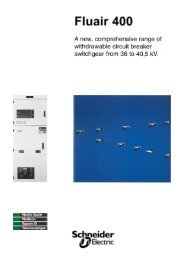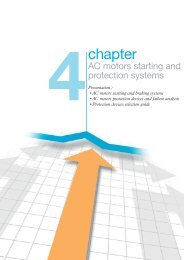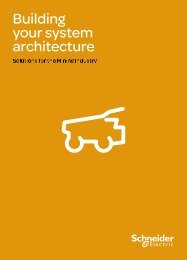Connect - Schneider Electric
Connect - Schneider Electric
Connect - Schneider Electric
You also want an ePaper? Increase the reach of your titles
YUMPU automatically turns print PDFs into web optimized ePapers that Google loves.
1 DESCRIPTION OF THE GROUP, AND ITS STRATEGY, MARKETS AND BUSINESSES<br />
ORGANISATIONAL SIMPLICITY AND EFFICIENCY<br />
• IT, which covers Critical Power & Cooling Services and two<br />
end- customer segments: Data Centres and Financial Services<br />
when it relates to solutions integrating the offers of several<br />
activities from the Group;<br />
• Buildings, which includes Building Automation and Security and<br />
four end-customer segments: Hotels, Hospitals, Offi ce Buildings<br />
and Retail Buildings.<br />
Rationalisation and optimisation of synergies<br />
The organisation is deployed in accordance with three key concepts:<br />
specialisation, mutualisation and globalisation. Specialisation mainly<br />
concerns sales and front-offi ce operations. Mutualisation covers<br />
local back-offi ce operations at the country and regional level.<br />
Globalisation concerns the six support functions, now known as<br />
Global Functions:<br />
• Finance;<br />
• Marketing;<br />
• Supply chain;<br />
• Human resources;<br />
• Strategy & Innovation;<br />
• Information systems.<br />
A substantial portion of the Global Functions’ costs is re-allocated<br />
to the businesses using distribution keys or application bases that<br />
are generally defi ned annually.<br />
• Specialisation: in each country, each business has its own sales<br />
force and local leader as soon as it reaches critical mass. It also<br />
has a specialised front offi ce in each host country to respond<br />
more effectively to customer demand for specifi c expertise.<br />
Each business is also responsible for its overall results, both<br />
for product sales (in its business lines) and the implementation<br />
of solutions (especially for end-customer segments within its<br />
scope). Over the course of 2011, the main efforts in this area<br />
focused on strengthening, and in certain cases, implementing<br />
teams dedicated to meeting the specifi c needs of strategic<br />
customer segments with a strong focus on the collaboration<br />
between the business lines, in order to ensure these customer’s<br />
needs are met as fully as possible. In addition, the 2011 rollout<br />
Operational<br />
companies<br />
32 2011 REGISTRATION DOCUMENT SCHNEIDER ELECTRIC<br />
<strong>Schneider</strong><br />
<strong>Electric</strong> SA<br />
<strong>Schneider</strong> <strong>Electric</strong><br />
Industries SAS<br />
of a common Customer Relation Management (CRM) tool for all<br />
the businesses, for use from the end of 2011 by 17,000 front<br />
offi ce equipment users, represented an important improvement<br />
for better sharing of sales opportunities between the various<br />
business lines.<br />
• Mutualisation: a country President is appointed in each country<br />
to oversee the Power business (and therefore, of its income<br />
statement), deployment of <strong>Schneider</strong> <strong>Electric</strong>’s strategy in the<br />
country (including all local cross-functional issues such as<br />
increasing cross-selling among businesses) and pooling of local<br />
back-offi ce resources. These resources are gradually brought<br />
together in each country or region under the country President’s<br />
supervision and can include multiple local support functions<br />
ranging from administration to project execution, depending<br />
on the situation. In addition, the country President serves as<br />
<strong>Schneider</strong> <strong>Electric</strong>’s main representative in the country, notably<br />
in dealings with employees and local offi cials. The signifi cant<br />
advances to note for 2011 in terms of this objective lie in the<br />
alignment between the information systems development plan<br />
in the different regions and the back offi ce integration projects<br />
resulting from the creation or acquisition of various entities in<br />
different countries.<br />
• Globalisation: major support functions that are not specifi c to<br />
a given country or business are gradually globalised to increase<br />
experience and leverage a signifi cant scale effect. Manufacturing<br />
and supply chain operations, areas of shared services or expertise<br />
(such as fi nance or human resources), information systems and<br />
certain marketing functions (e.g. web services) are now included<br />
within the Group’s Global Functions. Over the course of 2011,<br />
these various Global Functions have followed their structuring<br />
and rollout approach at a global level. In particular, the volume of<br />
operations dealt with by the service centres shared by the Finance<br />
and Human Resources functions (Finance shared services and<br />
HR shared services) has been a signifi cant development.<br />
Geographic dimension and legal structure<br />
The Group’s goal is to establish, and where possible, a single legal<br />
structure in each country.<br />
<strong>Schneider</strong> <strong>Electric</strong>’s simplifi ed legal organisation chart is as follows:<br />
Boissière Finance<br />
The list of consolidated companies is provided in note 32 to the consolidated fi nancial statements (see pages 205 and following ).<br />
Boissière Finance is the Group’s centralised cash-management structure; it also centralises hedging operations for all subsidiaries.

















